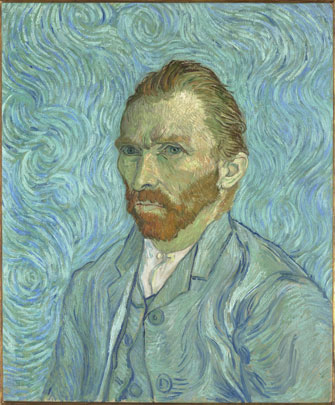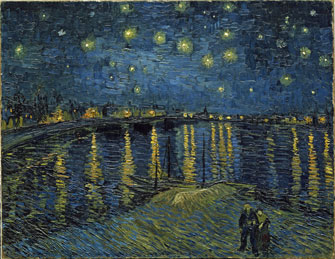Artaud: Van Gogh Killed by
Society and Shrinks

“Self-Portrait” (1889). © Musée d’Orsay, dist. RMN-Grand Palais/Patrice Schmidt
Any excuse is a good one to put together an exhibition of paintings by Vincent Van Gogh, and the curators at the Musée d’Orsay have found an unusual one, based on a text called Van Gogh le Suicidé de la Société (Van Gogh, The Man Suicided by Society), written by the French playwright, poet, actor and theater director Antonin Artaud, inventor of the “Theater of Cruelty.”
In 1947, Artaud, who himself had spent nine years of his life in a psychiatric hospital and hated doctors in general and psychiatrists in particular, wrote the piece after seeing an exhibition of Van Gogh’s work at a Paris gallery.
Artaud’s theory as to exactly how society drove Van Gogh to suicide are not made crystal-clear in the exhibition, in spite of numerous quotes from the book and even a live actor reading from the text. What little I was able to gather from the show itself seemed rather garbled and a bit off the wall. Dr. Gachet, the physician who took care of Van Gogh at the end of his life in Auvers-sur-Oise and became his friend and the subject of two of his most famous portraits, comes under special attack from Artaud, who claims that the artist’s insanity was his soul’s response to the imbecility of those who called him insane and that he killed himself because he couldn’t kill Dr. Gachet. Artaud placed direct responsibility for Van Gogh’s death on the art-loving doctor, a “sorcerer,” who, “desperate to to satisfy his hatred and jealousy of genius, pushed him to paint to the point of exhaustion.”
Those who are truly interested can read Artaud’s text, which was published by Gallimard in 1990, and look at his own tortured drawings, which are included in the show, but for me it is the beautiful collection of 40 Van Gogh paintings that make this exhibition a must-see. Several are from private collections, and unless you are planning a tour of museums large and small around the world, from Washington, D.C. to Helsinki, you may never have another chance to see some of these paintings firsthand. Others are more readily visible in the Musée d’Orsay itself and in the Van Gogh Museum in Amsterdam.
Familiar favorites that are always worth seeing again include “Van Gogh’s Bedroom in Arles”(1889), the much-loved “Starry Night” (1888) and “The Church at Auvers” (1890), all of

“Starry Night” (1888). © RMN-Grand Palais (Musée d’Orsay)/Hervé Lewandowski
which belong to Orsay. The exhibition also brings together no fewer then four self-portraits (in which Artaud saw evidence of the artist’s “extra-lucidity”) belonging to different museums.
Notable among the works from private collections are “Entrance to a Quarry near Saint Remy” (1889) and “Plate with Two Red Herrings” (1889). I was happy to see again one of my favorites, “The Garden of the Asylum at Saint-Rémy” (1889), from the Kröller-Müller Museum in Otterlo, the Netherlands, with its richly painted, shimmering surface, and one that I had never seen before, the lovely “Farm near Auvers,” from the Tate Museum in London, so peaceful and cheerfully bright and colorful – ironic considering that Van Gogh painted it in July 1890, the very month of his death by suicide. What would Artaud make of that?
Musée d’Orsay: 1, rue de la Légion d’Honneur, 75007 Paris. Métro: Solferino. RER: Musée d’Orsay. Tel.: 01 40 49 48 14. Open Tuesday-Sunday, 9:30 a.m.-6 p.m., until 9:45 p.m. on Thursday. Admission: €11. Through July 6, 2014. www.musee-orsay.fr
Reader reaction: Click here to respond to this article (your response may be published on this page and is subject to editing).
Please support Paris Update by ordering books from Paris Update’s Amazon store at no extra cost. Click on your preferred Amazon location: U.K., France, U.S.
More reviews of Paris art shows.
© 2014 Paris Update
Favorite